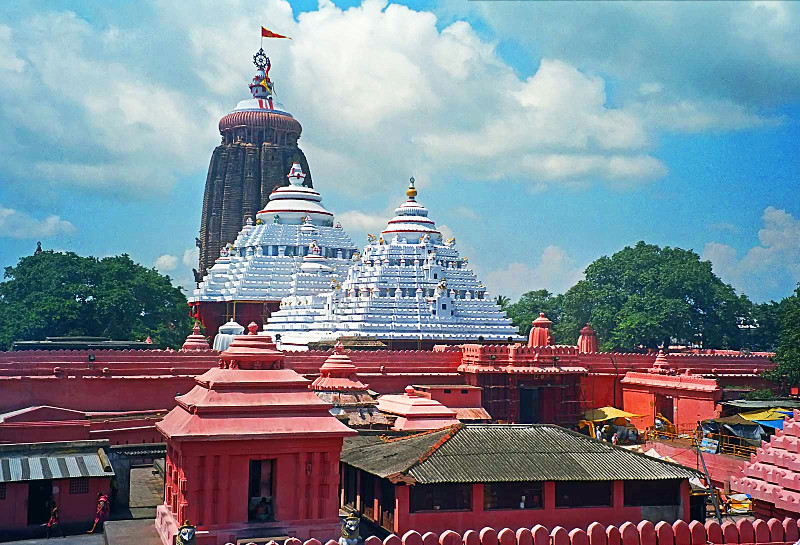
sparshanad eva tat kshetram, nrinaam mukti-pradayakam
yatra saakshaat pram brahma, bhaati dhaarava-lilayaa
api janma-shataihi saagrair, duritaachaara-tat-parah
kshetre asmin sanga-maatrena, jaayate vishnu samam
Touching Sri Kshetra Dham gives liberation to human beings. Lord Vishnu enjoys pastimes here, playing as a wooden Deity. By performing difficult austerities for a hundred births, one is able to touch Sri Kshetra Dham and attain a form like Lord Vishnu. (Sri Vyasadeva)
Jagannath Puri is a temple city in the Indian state of Odisha located 60 kms from Bhubaneswar, the capital city of Odisha on the seashore of Bay of Bengal. Jagannath Puri is one of the four holy Dhamas of India along with Dwarka, Rameshwaram and Badrinath. Jagannath Puri is the spiritual capital of Odisha and also known by other names such as Sri Purushottama Kshetra, Martya Vaikuntha or the abode of Lord Vishnu on Earth, Srikshetra, Nilachal, Nilagiri, Shankha Kshetra or Jagannatha Dhama. This holy city finds mention in various ancient texts such as Rig Veda, Kurma Purana, Narada Purana, Padma Purana and the Vishnu Khanda of the Skanda Purana.
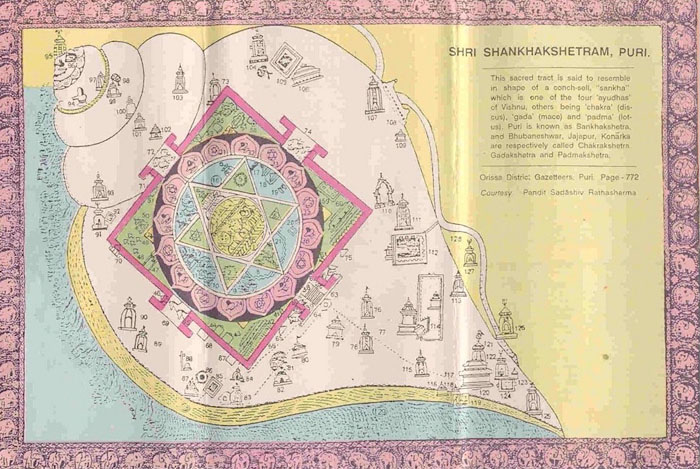
The most significant aspect of Jagannath Puri is the Jagannath Temple which is famous for it’s huge Deities of Lord Jagannath, Lord Baladeva and Devi Subhadra and Their annual Ratha Yatra (chariot festival) which is the largest religious gathering on the planet. The Puri Ratha Yatra attracts devotees from all over the world. In the Skanda Purana, the chapter called as Purushottama Kshetra Mahatmyam delineates the glories of Jagannath Puri. In this chapter, Jaimini Rishi states that anyone desiring to visit Sri Purushottama Kshetra will become free their past sinful reactions.
History of Jagannath Puri
Puri was the capital of the province of Odisha and the headquarters of the Collector till 1816. The ancient city of Purushottama Kshetra was established by King Indradyumna after the installation of the Deities of Lord Jagannath. Over the period of long years, the city has been looted and destroyed by Muslim rulers and rebuilt and reestablished by various Kings. The Jagannath Temple was invaded eighteen times during its history to loot the temple treasures. However, the Deities were taken to safe places by the head priests during the time of invasion.
Since the days of first Sankaracharya who visited Jagannath Puri perhaps by 810 A.D. and founded the Govardhana Matha, Puri has gained special significance as one of the four dhamas of India. It is the eastern dhama and one of the four Sankaracaryas of lndia stays here. It is believed that, there were 752 Mathas i.e., religious endowments, constituting institutions for the study and propagation of religious creeds in Puri. But now, about a dozen of them deserve mention. The arrival of Sri Chaitanya Mahaprabhu, a great Gaudiya Vaishnava saint from Bengal in the 14th century increased the significance of the Bhakti movement with Puri as one of the major seats of Gaudiya Vaishnavism. As per the scriptures, Sri Chaitanya Mahaprabhu is the incarnation of Lord Krishna in the mood of Srimati Radharani.
Just like Jagannath Puri is glorious, its residents are also so glorious as they drink the nectar of Lord Jagannath’s pastimes every day. In the Brahma Purana, Lord Brahma says that all the residents of Puri have four arms (sarvan eva chatur-bhujah). Purushottama Kshetra is so amazing that even the donkeys living there have four arms, then what to speak of the human beings.
aho kshetrasya mahatmyam samantad-dasha-yojanam
divishthaa yatra pashyanti sarvaan-eva chaturbhujaan
The glories of Purushottama Dhama are extraordinary. The Devatas from the heavenly planets look upon all living beings within a radius of ten yojanas of this sacred land as four handed residents of Vaikuntha.
In the Garuda Purana, Vyasa Deva goes on to explain
yatra sthitaa janaah sarve, shankha-chakraabja-paanayah
drishyante divi devaamsh cha, mohayanti muhur muhuh
When the devatas see that the residents of Puri are four armed residents of Vaikuntha holding a shankha, chakra and lotus in their hands, they faint numerous times.
DIFFERENT NAMES OF JAGANNATH PURI AND THEIR SIGNIFICANCE
Sri Kshetra – The word Sri refers to the internal potency of Lord Jagannath known as Lakshmi Devi. Hence, the tract of land predominated by Sri shakti is called as Sri Kshetra. The local residents and Odiyan Vaishnavas refer to the main temple of Lord Jagannath as Sri Mandir and not Jagannath Mandir.
Sri Purushottama Dhama – Lord Krishna resides here in the form of the archa vigraha called Sri Jagannath Dev or Sri Purushottama Dev and hence, Puri is called Sri Purushottama Dhama.
Jagannath Puri Dhama – Jagannath means the Lord of the universe and hence, his sacred abode is called as Jagannath Puri Dhama.
Sri Shankha Kshetra – The land area of Puri resembles the shape of a conch and hence called Shankha Kshetra. Lord Vishnu’s four weapons are represented in four different places in Odisha (also known as Odradesha), Shankha Kshetra is Jagannath Puri, Padma Kshetra is Konark, Chakra Kshetra is Bhubaneswar and Gada Kshetra is Jajapura. Of the four, Shankha Kshetra is the best as the Lord resides in His deity form as Jagannath Swami with all his majesty, beauty and sweetness.
Nilachala Dhama – There is a small mountain situated in the middle of Puri which is bluish in color on which the current day Jagannath temple is located. Hence, the name Nilachala Dhama. Earlier, Lord Jagannath was known as Nila Madhava whose Deity was made of a dazzling blue stone and worshipped by the local tribesmen called as Sabaras.
Dasha Avatara Kshetra – It is said that Lord Vishnu originally manifests his different avataras in Puri and then goes to other places to enact the lilas associated with that avatara. After finishing the particular lila, the Lord returns to Puri. The Skanda Purana says that one gets the result of seeing the Dasha Avataras of Lord Vishnu by having just one darshan of Lord Jagannath.
Bhauma Vaikuntha – As per the Kapila Samhita, Puri is a direct replica of Vaikuntha (sakshat vaikuntha rupam tat). Hence, it is the best of all kshetras and tirthas.
Narasimha Kshetra – Puri is called as Narasimha Kshetra in the Padma Purana. When Lord Brahma had perfomed the installation ceremony of the Jagannath Temple, Lord Narasimha manifested from the yagna kunda in a ferocious form which frightened King Indradyumna. Seeing this, Lord Narasimha assumed a peaceful form.
Bhusvarga – As per the Skanda Purana, Puri is known as Bhusvarga i.e. heaven on earth. The Brahma Purana says that Puri is a very divine abode unlike any other place on earth which is rarely attained even by the devatas.
Puri Dhama – The word Puri means residence. Lord Jagannath is the parama purusa i.e. the supreme person who lives here and hence called Puri Dhama.
BENEFITS OF VISITING JAGANNATH PURI
As per the Skanda Purana, in Dvapara yuga, Lord Sri Krishna and Arjuna visited Nilachala Dhama i.e. Jagannath Puri for three days. They observed vratas and had darshan of Lord Jagannath.
In the Padma Purana, Sage Narada tells the great devotee Prahlada – “One who sees or even hears about the Supreme Lord manifest on the summit of Nilachala hill will attain Lord Vishnu’s abode”
In chapter eleven of the Padma Purana, Lord Vishnu tells Lord Shiva – “I eternally reside in Sri Kshetra and I eat there everyday. By sleeping in Puri, one obtains the result of samadhi, and lying down here brings the results of offering obeisances. By wandering around Puri, one obtains the result of parikrama. Every word spoken here is a prayer glorifying me. Puri is so sanctified and pure that one attains the result of eating havishya (boiled rice with ghee) even by eating fish. Everyone who resides in Jagannath Puri is equal to me. Yamaraja has no jurisdiction to punish anyone in Puri.”
The Shiva Purana says the following about Puri Dham –
aaste ananto avyayo vishnuh, purana purushottamah
muktim dadaati yo devah, saptadha bhakta-vatsalah
smaranad bhakshanaad, tatha naamaanakirtanaat
khsetre vaasaad asu-tyaagaad, darshanaach ca yathaa tathaa
The unlimited, imperishable and primeval Sri Purushottama Deva resides in Puri. Being warmly affectionate to his devotees, Sri Jagannath Dev bestows liberation in the following seven ways – by remembering him, by honoring his mahaprasadam, by visiting his holy abode, by chanting his holy names, by residing in his holy dham, by having his darshan or by dying there.
The Brahma Purana states that by bathing in any one of the five sacred places in Jagannath Puri, a person will get liberation. These places are –
1. Indradyumna Sarovar
2. Markandeya Sarovar
3. Sveta Ganga
4. Rohini Kunda
5. Sea at Puri/Mahodadhi (All sacred rivers of India flow into this sea)
Places to visit in Jagannath Puri
Devotees can visit the following temples in Jagannath Puri:
Jagannath Temple, the main attraction of Puri dedicated to Lord Jagannatha, Lord Baladeva and Subhadra Devi.
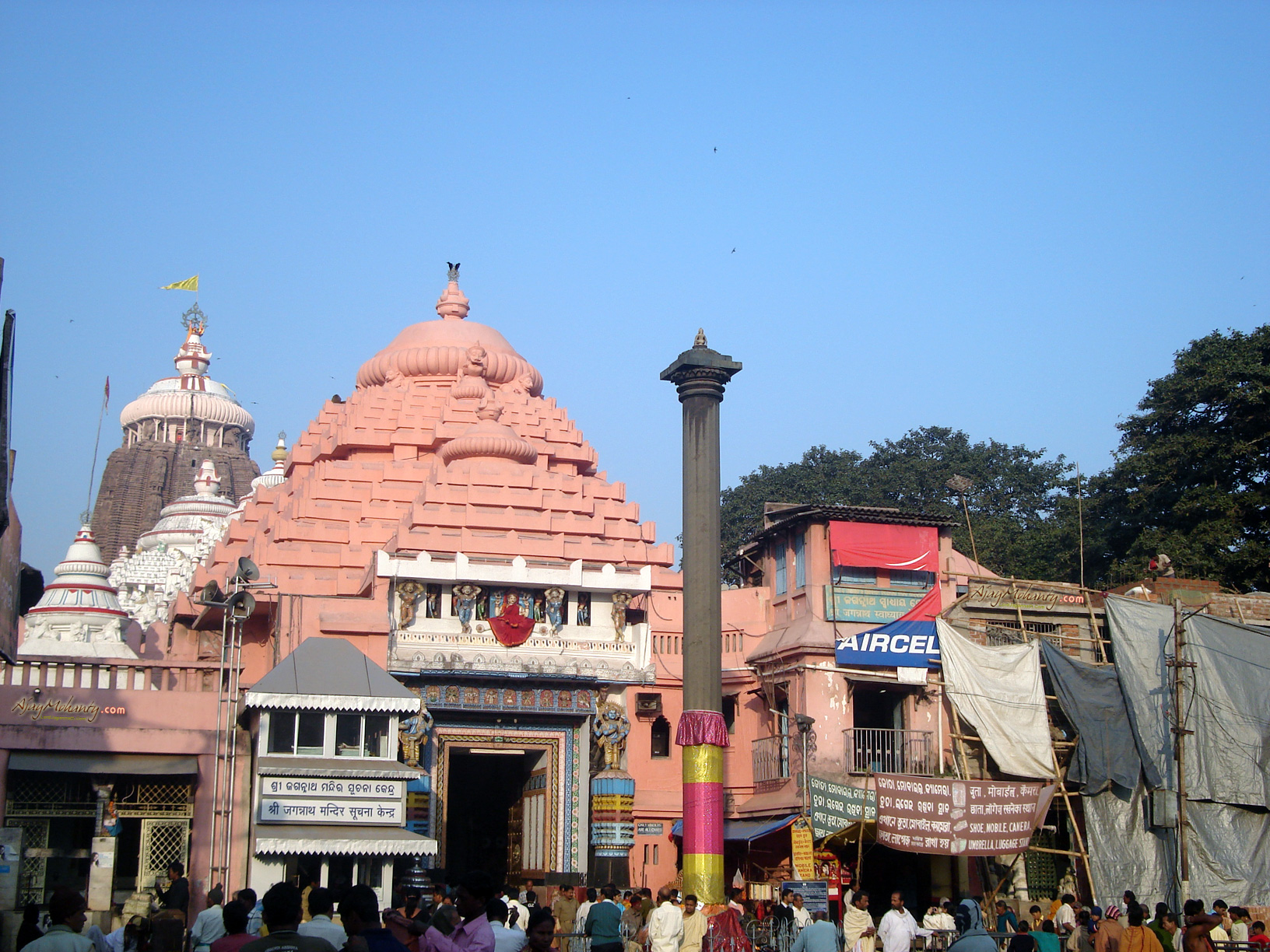
PC: Ajay Mohanty(flickr)
Alalanatha Temple, also known as Brahmagiri where there is a temple of Lord Jagannatha and a stone slab containing the imprint of Sri Chaitanya Mahaprabhu’s body. The Deity here called as Alwarnatha is said to have been consecrated by one of the Alwars.
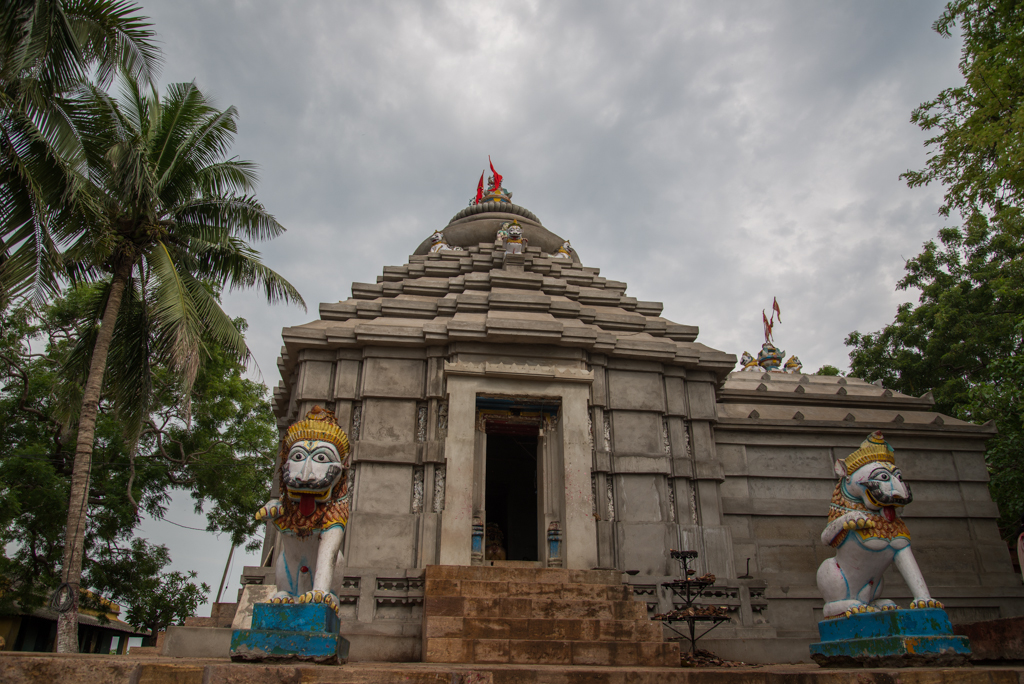
PC: Saurabh Chatterjee(flickr)
Narendra Sarovara, which is a large water tank with a temple in the middle dedicated to Lord Jagannath, Baladeva and Subhadra Devi. Behind them, there is a Deity of Yashoda Devi, the mother of Lord Krishna. At the other end of the temple rooms is the Deity of Lakshmi Devi. A temple of Lord Shiva and Balakrishna are also present here.
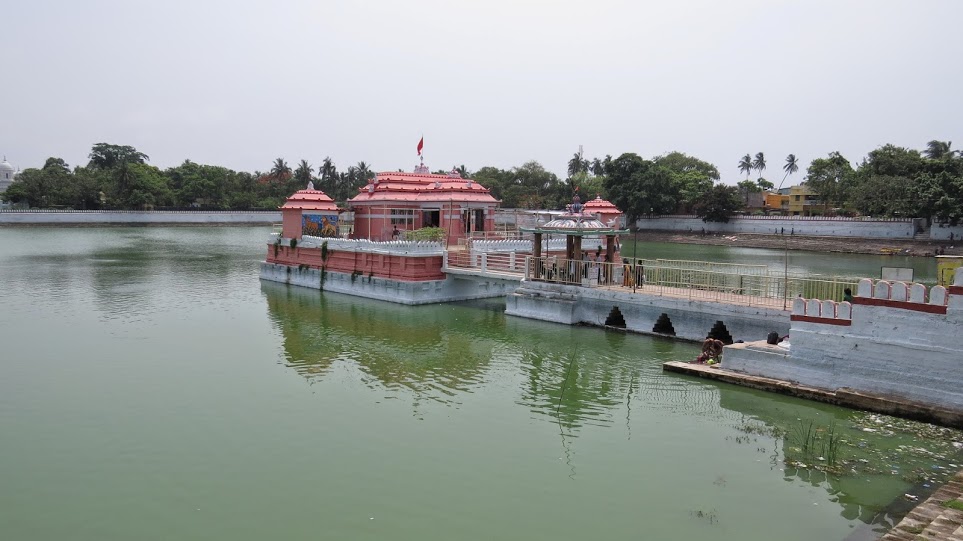
PC: indiamike
Balagandhi, where Lord Jagannath’s chariot stops to accept Bhoga offerings.
Jagannath Vallabha Gardens, which resembles Vrindavana. There is a temple of Lord Jagannatha here.
Bhaktisiddhanta Swami’s birth place which is worth visiting. He is the founder of the Gaudiya Math. The Gaudiya Math temple houses the Deities of Lord Jagannath, Bhaktisiddhanta Swami as well as that of the Acharyas of the four sampradayas i.e. Vishnuswami, Madhvacharya, Nimbarka and Ramanuja.
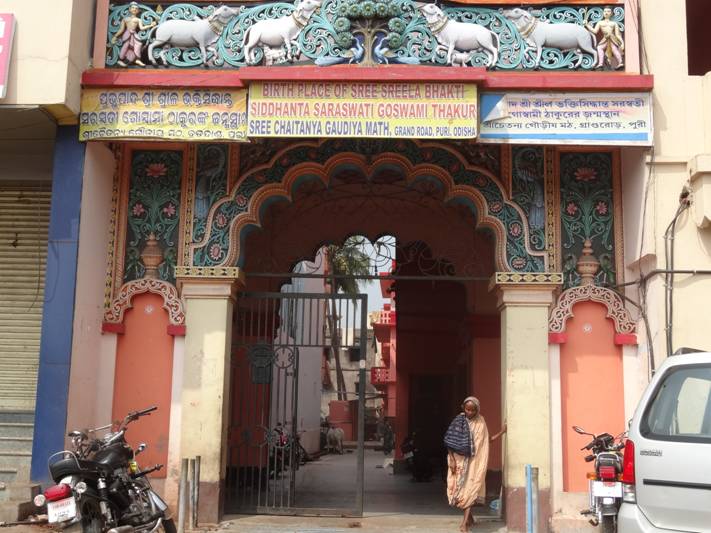
PC: dandavats
Gundicha Temple, where Lord Jagannath stays for a week during the Ratha Yatra festival.
Narasimha Temple which stands next to the Gundicha Temple and houses two Deities of Lord Narasimha, one called as Santha Narasimha (Narasimha who is sober) and the other is Raga Narasimha (Narasimha who is angry). It is said that one who has darshan of Santha Narasimha will be able to free themselves from anger, anxiety and frustration.
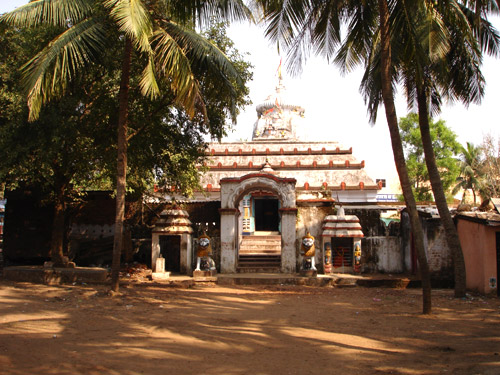
PC: shreekhetra
Indradyumna Sarovara Kunda from which water is drawn to clean the Gundicha Temple.
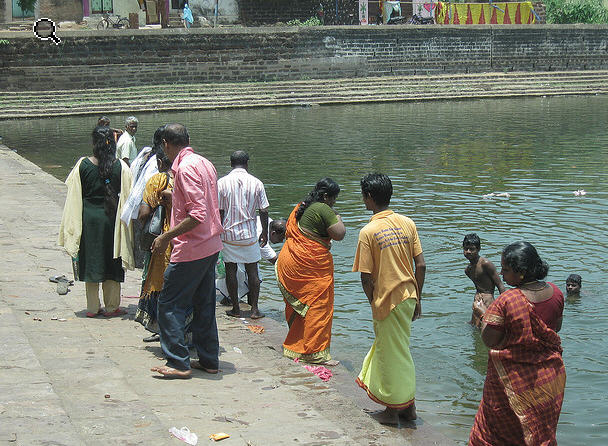
PC: jagannathpuri
Paramananda Puri’s well whose water is said to be non-different from the waters of river Ganga. It is said that the water of the well was bitter and hence, Lord Chaitanya Mahaprabhu prayed to Lord Jagannath to allow the water of river Ganga to flow into the well and make it sweet. The prayer was accepted and the water turned sweet.
Sarvabhauma Bhattacharya’s house contains a hidden tunnel which is said to lead in two directions i.e. one towards the sea and the other towards the Jagannath temple. Sarvabhauma Bhattacharya was a great devotee of Lord Jagannath.
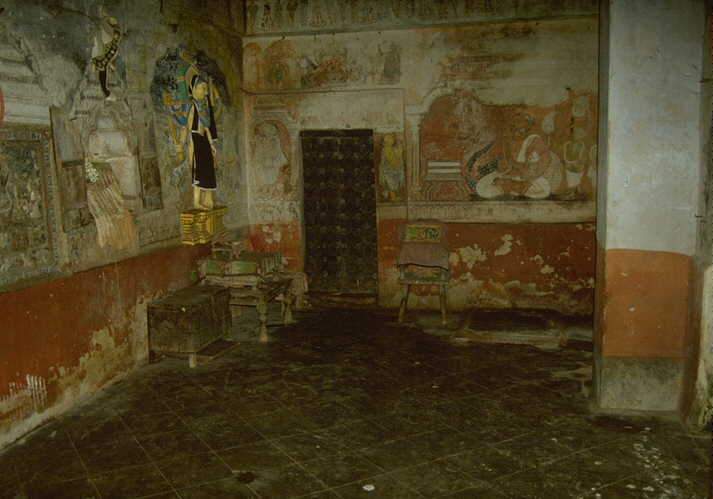
PC: iskcondesiretree
Siddha Bakula is the bhajan kutir of Haridasa Thakura who was a great devotee of Lord Jagannatha inspite of being born into a Muslim family. He used to chant 300,000 holy names of the Lord everyday. The neem tooth stick of Lord Jagannath was planted here by Sri Chaitanya Mahaprabhu which grew into a tree in moment.
Kasi Misra’s house which used to be the residence of Lord Chaitanya Mahaprabhu. There is a room seen through a small barred window called Sri Gambhira where the Lord lived. Here one can also have darshan of akhanda jyoti lit by Chaitanya Mahaprabhu and the slippers of Chaitanya Mahaprabhu.
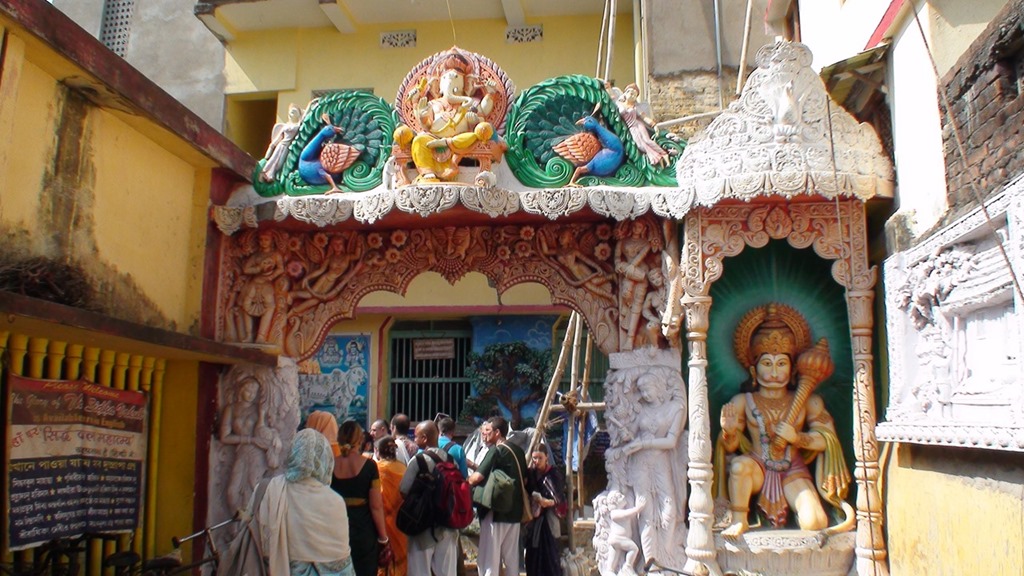
PC: orissabengalyatra2015
Bhaktivinoda Thakur’s Bhajan Kutir
Haridas Thakur’s Samadhi
Chakra Tirtha Temple
Geography of Jagannath Puri
Jagannath Puri lies over an area of 3051 sq km with a population of 1.5 million. Most of the rivers flowing through Puri are distributaries of the river Mahanadi. There are no hills within the boundaries of Puri.
How to reach Jagannath Puri
Puri is well connected to other parts of the country through bus, train and flights.
By Bus – there are buses from Bhubaneshwar, Cuttack and other cities by the state transport corporation. Odisha Tourism Development Corporation run buses for sightseeing in Puri.
By Train – trains connect Jagannath Puri city to other important railway stations in the country like New Delhi, Mumbai, Bhubaneshwar, Kolkata, Raipur, etc
By Flight – the nearest airport is the Biju Patnaik airport in Bhubaneshwar at a distance of 60 kms. There are regular flights to Bhubaneshwar from New Delhi, Mumbai, Kolkata, Vishakapatnam, Bengaluru and other cities.











4 Comments On Jagannath Puri
Vandana
Thank you for this insightful article. I am planning to visit Shri Jagannath Dham for the first time. All the detail mentioned here will be truly helpful. It’d have been great if some accommodation options too could have been shared.
Thanks once again.
SANJAY BANERJEE
I was mesmerized while going through this beautiful presentation. I have visited Puri Dham several times but have missed some of these holy sites. Tirtha Yatra, next time I will definitely join you for a memorable Tirtha.
Thank you so much for your lovely comment. You are always welcome to join us. Jai Jagannath
A.vasantaa
Just two days back completed puri jagannath yatra with tirtha yatra. Wow that night bada stringer dharshan……. still fresh in memory. Blessed to have mahaprasadam. That is amrutham!!! One must visit puri and have dharshan of lord jagannath in their life time. When I close my eyes I can see only jagannathas big eye. My sincere thanks to tirtha yatra team for the success of the trip and special mention to shri aghrani Krishna das for the wonderful arrangements and beautiful narration of sthalapurana and unknown stories of the lord.